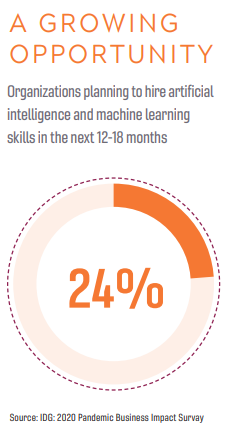AI/ML Education: A Business Necessity — A Career Advantage
June 2021

Few technologies are driving the transformation of business as quickly as artificial intelligence and machine learning. Sophisticated algorithms can help HR managers identify high-potential hires; warehouse workers map out the fastest way to ship inventory; marketers pinpoint the preferences of customers; and sales teams upsell products at optimized prices.
Despite these business benefits, moving AI and ML projects into production can be challenging. Enterprise data often exists in silos, making it difficult to integrate with AI. At the same time, ML deployments can be time-consuming, costly, and difficult to scale.

One way to minimize these challenges is by ensuring nearly every IT and business professional has at least a working understanding of AI and ML. In fact, according to an IDG 2020 Pandemic Business Impact Survey, 24% of organizations plan to hire for AI/ML skills in the next 12-18 months. “AI and ML are such powerful technologies,” says Kendall Giles, a faculty member in Virginia Tech’s online Master of Information Technology (MIT) degree program. “The more you can spread an understanding of these technologies throughout your organization, the better off everyone will be.”
Fortunately, there is a way for professionals to successfully enhance their AI/ML know-how: Virginia Tech’s fully online MIT degree program, specializing in Innovation and Entrepreneurship in AI/ML. More than simply a boon for any business environment, this innovative program can position an individual to be in front of a surge of professional demand. Here’s how.
AI/ML IN ACTION
Today’s AI/ML technologies touch all aspects of the computing environment, from front-end systems to back-office workflows. IT and business leaders alike are taking note: An IDG survey reveals that the majority of organizations are in the researching and piloting stages (57%) of AI/ML deployment. However, a solid percentage already have this technology in place either enterprise-wide or within a business unit/division (42%).

Better yet, many are realizing significant business value from their investments. For some, this means the ability to process information, such as financial data and customer interactions, at a higher speed than humans and with fewer errors due to sophisticated algorithms. For others, AI/ML lets IT leaders quickly understand pressing problems and execute a plan of action. AI-powered cybersecurity tools which can detect threats before they have a chance to wreak havoc on IT infrastructure are a perfect example.
Another AI/ML advantage: the potential to reduce the drudgery of completing time-consuming rote and manual tasks, enabling leaders to focus on more business-critical activities.
OVERCOMING OBSTACLES WITH EDUCATION
As reliance on AI and ML grows, so too does the need for talent with the knowledge and skills to use these tools in a robust business and IT environment. Data-related challenges are the most common obstacles when moving AI projects to production. Enterprise data can be siloed across hundreds of systems such as data warehouses, data lakes, databases, and file systems. And ML frameworks such as TensorFlow and others don’t do data processing.
However, by honing one’s AI/ML skills, IT leaders can learn how to unify data processing with ML frameworks and facilitate data science collaboration across the ML lifecycle. Model drift is another example of an AI/ML challenge that can be addressed with enhanced know-how. Over time, machine learning models tend to drift and require retraining. Fortunately, Virginia Tech’s online MIT program can teach students how to keep a model current so that its output — mission-critical predictions and recommendations—remains relevant to the business.
WHILE MOST AI AND ML PROGRAMS FOCUS ONLY ON ALGORITHMS, THE MIT PROGRAM OFFERS BOTH A TECHNICAL FOUNDATION AS WELL AS LEADERSHIP SKILLS.
KNOWLEDGE GAINS
From an educational standpoint, Virginia Tech’s online MIT degree program with a specialization in AI/ML strikes a perfect balance between improving business acumen and enhancing IT skills by covering areas ranging from strategic leadership and entrepreneurship to innovative pathways in AI/ML.
“With all the challenges of deploying AI systems, IT and business leaders need a wide variety of expertise, from operational to strategic skills, to identify problems that can be solved with AI,” says Giles. “While most AI and ML programs focus only on algorithms, the MIT program offers both a technical foundation as well as leadership skills.”
Another key differentiator of the online MIT program: Students hail from a wide variety of industries and disciplines. This comes in handy when it’s time to divide them into groups to develop a problem involving an interesting data set, either public or proprietary. In most cases, the goal is to tackle a predictive application, algorithm, or task that makes sense for a particular domain.
“Students come from all of these different backgrounds and have a wide variety of skills, which leads to some interesting discussions and perspectives,” says Giles. “By contributing these unique insights, they improve the learning experience for everyone.”
THE BOTTOM LINE
Across industries, disciplines, and roles, AI and ML are driving the transformation of business and value creation in new directions. The good news is IT and business leaders can follow these new pathways, and chart a promising career trajectory by completing an online Master of IT degree specializing in Innovation and Entrepreneurship in AI/ML.





